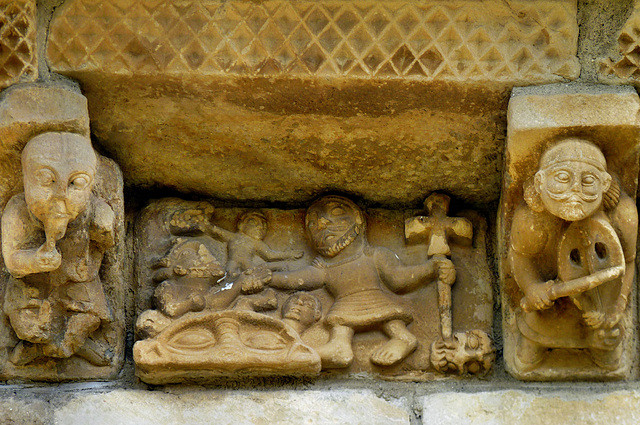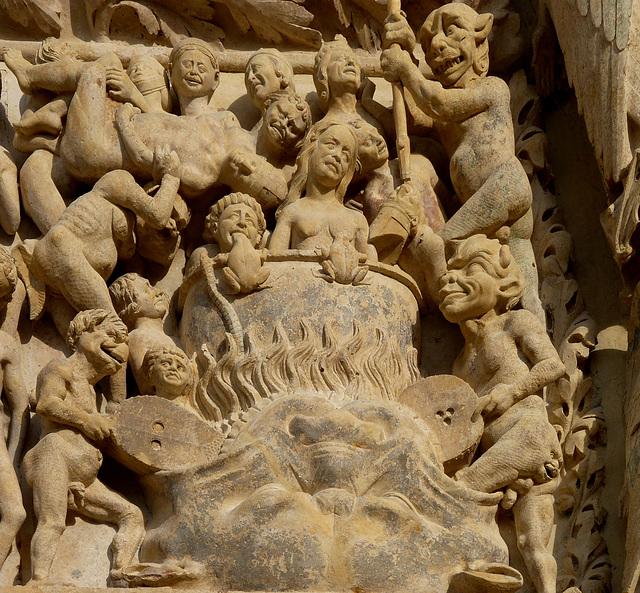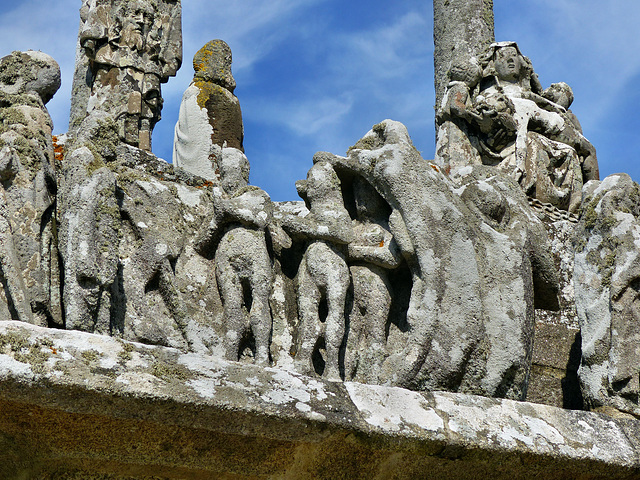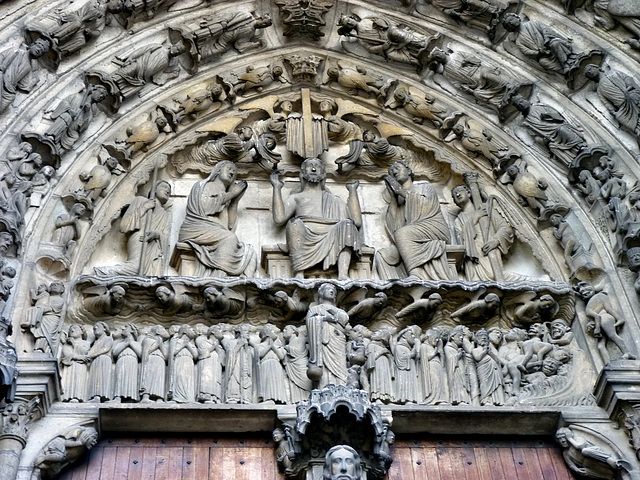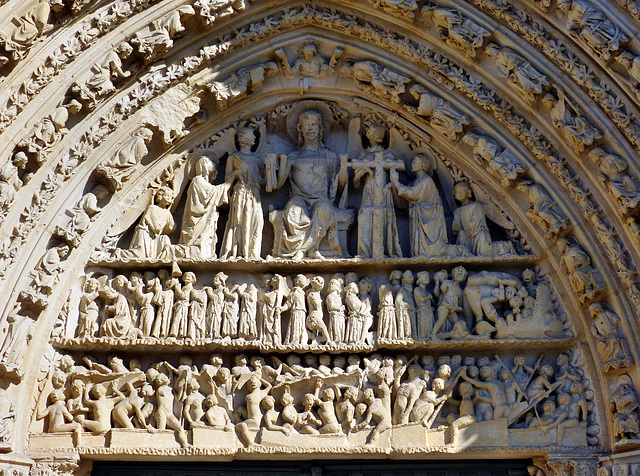
The Jaws of Hell
The Hellmouth is the entrance to Hell. A gaping mouth of a huge monster, an image which first appears in Anglo-Saxon art, and then spread all over Europe.
Artaiz - San Martin
This church, dedicated to Saint Martin of Tours, was a real surprise to me. The single nave structure was probably erected within the 12th century. It was built in a "walking distance" off the pilgrim routes (like "San Pedro de Echano"), as the hamlet Artaiz is just about 10kms north of the "Camino Aragonés". San Martin will have been for sure a stopover for pilgrims, who had visited the tomb of Saint Martin of Tours, following the "Via Turonensis".
The masterly composed and carved portal of Saint Martin is extraordinary in the specific iconography, that in parts may reflect the relations to the Islamic neighbours (Reconquista). Here is a script by German arthistorian Hedda Finke about this subject.
art.unt.edu/medieval-symposium/presenter.php?year=2009&am...
Between the seven corbels under the portal´s roof are six reliefs.
This one depicts the "Harrowing of Hell".
In the time between Crucifixion and the Resurrection Christ (here without a nimbus!) descended into hell, bringing salvation to the righteous, who had died since the beginning (mostly symbolized by Adam and Eve). Here the giant mouth of the hell is open. Christ spears a beast with a cross, that reminds on a processional cross or a pilgrim's staff.
The corbels depict a flautist (left) and a musician with a vielle.
Sangüesa - Santa María la Real
"Santa María la Real" is one of the highlights for all people following the "Camino Aragonés" - since about 800 years. The facade is impressing it may take hours, to find out the many details. I stayed an extra day, when I had reached the town, just to see the shadows movig over the carvings.
A church did exist here already in 1131 next to the bridge crossing the river Aragon. It was transferred by Alfonso I to the "Knights Hospitaller" (aka "Order of Saint John", later "Sovereign Military Hospitaller Order of Saint John of Jerusalem of Rhodes and of Malta"). The apse is the oldest part of the structure and probably dates back to that time.
The nave and the breathtaking Southern Portal of Santa María la Real were created late 12th/13th century. I uploaded a "total overview" earlier and now will focus more on details.
A detail from the right side of the tympan, depicting the Last Judgement. The right side is actually on God´s left side, standing for the evil. - Here is the Weighing of the Souls (psychostasia). A large snake tries to pull down one side of the scale, held by the archangel. Beside the scale is the mouth of the hell, a nude couple is sinking into it. Below are the heads of the apostles, their fading names are written on the arches.
It seems that the artist knew the much older bas-relief from the portal in Artaiz (ca. 30kms west), as the hellmouth here has the same structure
Bourges Cathedral
Late afternoon sun in Bourges. The "Cathédrale Saint-Étienne de Bourges" was erected as a replacement for a 11th-century structure. The construction started probably in the last quarter of the 12th century, around the same time, when the builders and bricklayers started in Chartres. The choir of the cathedral was in use by 1214, the nave was finished 1255. The cathedral was consecrated in 1324.
The western facade was finished by 1270. It is very wide (42m), as the four side aisles and central nave each have their own portal. This is the tympanum of the center-portal, the largest and most ornate and sophisticated one.
The "Last Judgment", a popular theme already on Romanesque churches (eg Conques, Autun, Moissac, Sangüesa) is seen on the tympanum in a delicate Gothic style.
Here is a details of the middle level´s left side.
Ugly devils throw the souls into the hellmouth, but on top of the mouth stands a large boiler. Seem the hell only accepts them cooked. The two devils on the sides use bellows. The devil to the right has a second face, yes some may call this a ...../Sorry!
Since 1992 the cathedral is a "UNESCO World Heritage Site".
Bourges Cathedral
The "Cathédrale Saint-Étienne de Bourges" was erected as a replacement for a 11th-century structure. The construction started probably in the last quarter of the 12th century, around the same time, when the builders and bricklayers started in Chartres. The choir of the cathedral was in use by 1214, the nave was finished 1255. The cathedral was consecrated in 1324.
With the completion of the choir of the cathedral , the first stained glass windows got installed. Most of the windows around the choir, created 1220/1230, survived the times. The wonderful "vitraux" here may even be a bit older than the more famous ones in Chartres.
Here is the Last Judgement.
The "Weighing of Souls" (Psychostasia) in the top part. In the center the the souls to the right are saved and move to Abraham, who holds the souls in a napkin on his bosom. Those souls to the right end in a hellmouth.
Chapelle Notre-Dame de Tronoën
Next to the Chapelle Notre-Dame de Tronoën is the large calvary, one of the landmarks of Brittany.
Erected 1450/1470, this is the oldest of the great calvaries in Brittany. The rectangular base measures 4,5m x 3,5m. Under the crucifiction are two friezes, depicting themes from the New Testament. There are lots of scenes and details.
Harrowing of Hell (aka "Descensus Christi ad Inferos"). Adam, Eve and the first of the "righteous men and women" can be seen, striding through the Hellmouth.
Saint-Bertrand-de-Comminges - Cathedral
The village Saint-Bertrand-de-Comminges, named after a bishop of the once existing diocese here,was just like neighbouring Valcabrère once part of a large Roman settlement, that may have had about 30.000 inhabitants. In the early 5th century the Vandals sacked the city, in 585 merovingian troops razed the site, that probably had the bishopric seat already at that time.
Saint Bertrand of Comminges (1073–1123) restored and fortified the town. He commissioned the erection of the cathedral. Saint Bertrand´s tomb was a center of regional pilgrimage already before he got canonized around 1220.
Pope Clement V, who had once been Bishop of this diocese, strongly promoted the pilgrimage, so that soon after the Romanesque church was to small for the many "pelerins". Between 1304 and 1352 the major part of old nave got demolished to make room for a new, larger Gothic nave.
In 1586, during the Wars of Religion, the cathedral was looted and severely damaged by the Huguenot troops. It took the next centuries to restore and repair. Saint-Bertrand´s relics were hidden during the Huguenot raids and are meanwhile back in the cathedral.
One of the capitals of the portal depicts this a miser, money bag around around his neck. He gets stuffed into the hellmouth by devils unsing long forks. Animals (an eagle (left), a dog (right)) have started to maul the miser.
More infos can be found at the cathedral´s website:
www.cathedrale-saint-bertrand.org/
Bazas - Cathédrale Saint-Jean-Baptiste
Many pilgrims following the Via Lemovicensis visited Bazas, as since medieval times as the blood of John the Baptist was venerated here. The relic got lost during the French Revolution as well as the bishopric seat. The cathedral, dating mainly from the 13th-14th centuries, dominates the central square of Bazas. The western facade has three Gothic portals. Here is the tympanum of the center portal.
The trumeau depicts John the Baptist (only his upper body can be seen), holding the "Agnus Dei".
The trumeau depicts John the Baptist (only his upper body can be seen), holding the "Agnus Dei".
The tympanum has in the lowest tier some biblical scenes, connected to John´s life. The decapitation is to the very left.
The "Last Judgment", a popular theme
With the next tier the Armageddon begins. The "Last Judgment" was a very popular theme fpr tymoana since centuries. Here the graves open. The weighing of the souls is seen (very damaged) in the center of the next level. On the very right devils stuff poor souls into the hellmouth, while the persons on the left side go up to heaven. The angels, flanking Christ in the center above, hold the "Arma Christi" ("Instruments of the Passion").
Chartres - Cathédrale Notre-Dame
There have been five cathedrals on this site. One was destroyed by Visigothic troops mid of the 8th century. The successive cathedral was burnt down by Vikings ("Danes") in 858. The carolingian structure that was erected within the next decades was burnt down in 962 by troops led by Richard I of Normandy (aka "Richard the Fearless", "Richard Sans-Peur").
The rebuilding started again, but whatever was completed got destroyed by a fire, caused accidently, in 1020. The erection of a Romanesque cathedral started and most of the still existing crypt dates back to that building.
In 1134, another fire damaged the town and large parts of the cathedral. The towers got repaired and rebuilt and the portal between them got created. Another blaze hit the town in June 1194. The cathedral was burnt down. Construction works started the same year. The western towers and the undamaged western portal ("Portail Royal") got integrated into the new building.
The nave was already vaulted in 1220, the transept and the stained windows were completed in 1260. On 24 October 1260, only 66 years after the start of construction, the Cathédrale Notre-Dame was consecrated in the presence of Louis IX of France (aka "Saint Louis", "le Prudhomme").
Since Charles the Bald, Louis the Pious´ son, had given the "Sancta Camisia" to the cathedral in 876. Because of this "Veil of the Virgin" Chartres developed into a very important Marian pilgrimage center in medieval times.
The south transept portals were carved between 1225 and 1260, so these works are some decades younger than the northern portals and about a century younger than the Portail Royal. While the carvings there are still in a transition from Romanesque to Gothic style, the works of the South portal are Gothic - just like the portal of the Bourges Cathedral, often compared with this.
The portal was carved on the theme of the New Testament. Here is the tympanum. In the center of the lintel below, Archangel Michael holds a scale (that is lost). The psychostasia (weighing of souls) is done here. The way to heaven is left, the way to hell to the right. The hellmouth is seen in the corner.
Poitiers - Cathedral
On the ruins of a older basilica begann, just next to the Baptistère Saint-Jean the construction of large Cathédrale Saint-Pierre in 1162. The building, the new the seat of the Archbishop of Poitiers, was greatly funded by Henry II of England (aka "Henri II Plantagenêt") and Eleanor of Aquitaine.
The construction started as usual in the east and was completed with the western facade end of the 13th century.
The transition from the late Romanesque to the Gothic style is visible. The three Gothic portals of the western facade seem influenced by the Gothic cathedrals from northern France.
The tympanum of the central portal depicts the "Last Judgment", a "traditional" theme, as this can often found on Romanesque tympana.
The tympanum is densely populated and delicately carved. Tombs open on the lowest tier, while above them souls go to heaven (left) or enter the "Mouth of Hell" (right). Christ is flanked by angels, who hold the "Arma Christi". The icon "Instruments of the Passion" got popular during the 13th century.
Jump to top
RSS feed- Latest items - Subscribe to the latest items added to this album
- ipernity © 2007-2024
- Help & Contact
|
Club news
|
About ipernity
|
History |
ipernity Club & Prices |
Guide of good conduct
Donate | Group guidelines | Privacy policy | Terms of use | Statutes | In memoria -
Facebook
Twitter

